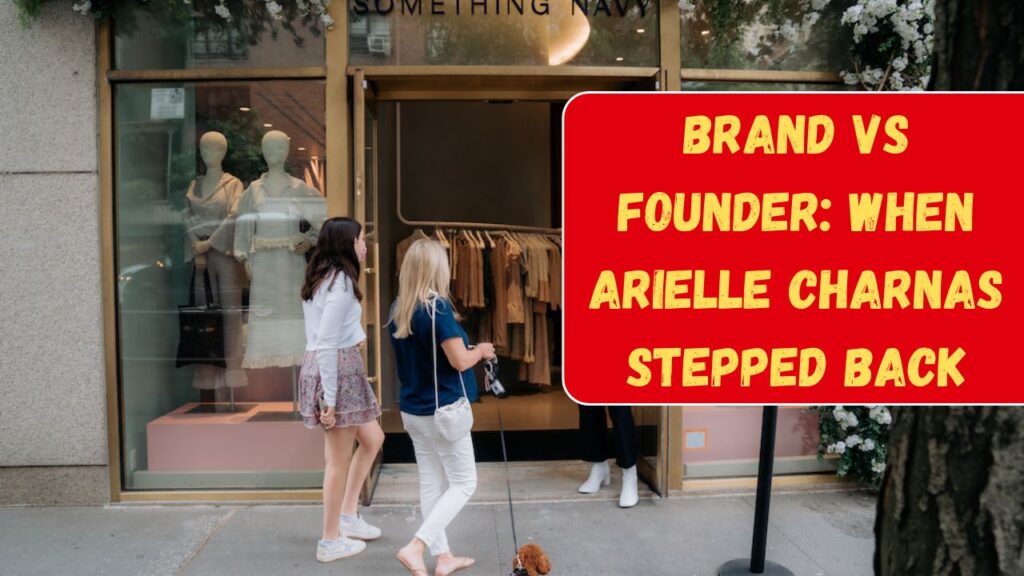Nowadays, the brand in the influencer and fashion economies is usually not an athlete or a movie star, but rather two people who founded something in Dayton’s case MVMT. Public image, style and personality shape the way consumers interact with them as a brand/business. But what happens if the founder falls out of favor or simply loses interest? Arielle Charnas’s Something Navy saga is a compelling case study in the tension between corporate sustainability and personal branding.

Who Is Arielle Charnas
Arielle Charnas began her career as a fashion blogger and the owner of Something Navy, which is now referred to as Arielle by pretty much everyone. Millions who became enamored with the figure of a relatable, carefully-branded New York City lifestyle and covetable-but-achievable sense of style. She then turned her followers into business deals — including an incredibly lucrative one with Nordstrom. The success of those capsule collections saw Something Navy grow into its own fashion brand in 2020. Charnas was the label, not just its creator.
Founder-Led Brands’ Ascent
Brands with close ties to their creators Glossier (Emily Weiss), Goop (Gwyneth Paltrow) and Skims, the shapewear brand by Kim Kardashian West, among them have thrived in today’s direct-to-consumer market. People are not buying things, they’re investing in a lifestyle and narrative. Founders themselves become role models, and their independent brands increase engagement with them as well as credibility. But there are risks in this model. An argument, mistake or personal decision from the founder can be a potential danger to the company when they are part of the brand.
Brand vs Founder: When Arielle Charnas Stepped Back
Arielle Charnas came under fire after a widely panned response to the spread of COVID-19 in early 2020. She endured a social media backlash when it was revealed that she secretly had tested positive for Covid and then spirited her family away to the Hamptons even as much of America’s public was still locked down.
Her behavior went viral and prompted internet users‘ anger, plus demands for accountability. She was condemned by some of her own supporters for pulling rank at a time of crisis. There were the fallout effects: The Navy had to try and control damage, alliances came under strain and brand trust was wiped out. Overnight, the founder’s off-duty life had become a liability for his company.
The Decision to Stay in the Shadows
Arielle Charnas increasingly withdrew her role from the more public-facing aspects of the business following harsh criticism and ever-increasing need to distance itself as a brand. She was still a founder and creative voice, but she began to work more behind the scenes and appeared less frequently in branding projects. Her own Instagram activity decreased. The Navy has recently pivoted to show itself as a normal fashion brand, not one reliant on influencers. It was a watershed moment for Charnas and her team, and changed the way that contemporary DTC brands think about sustainability.
Founder vs. Brand: The Core Conflict
The Charnas case underscores a broader conversation: What happens when the personality of the founder eclipses that of his brand?
Some key challenges that arise within founder-led brands include:
Dependency on Identity
When consumers focus too much on the single person, it can be difficult to grow a brand beyond one founder’s (often small) audience or image.
Risk to Reputation
Founder-level personal conflicts can become business problems. This is especially dangerous in a time when cancelled culture runs rampant.
Limited Life Expectancy
The brand could struggle to reinvent itself without the founder at its helm, or significantly involved.
Bottlenecks in creativity
Over-dependence on the founder’s vision might stultify creativity or limit access to diverse perspectives.
The Navy had to consider all of those factors simultaneously in the Arielle Charnas case.
The Business Response: Brand Autonomy Reinstituted
After being the subject of backlash, Something Navy made deliberate moves to shift focus away from Arielle Charnas and towards a larger lifestyle identity:
An expanded range of models and marketing: The company began to use more diversified models in advertisements.
- Retail Expansion: With or without the founder onboard, physical stores in major cities were meant to be pure fashion destinations.
- New Leadership : To professionalize its operations and stimulate growth beyond influencer marketing, the company recruited experienced retail executives.
- Product-Driven Storytelling: Campaigns focused less on Charnas’ particular style and more of the products themselves, including a focus on product quality, design philosophy and customer experience.
- From “Arielle Charnas’ closet,” the brand slowly shifted into an independent fashion company with its own values and objectives.
FAQs On Brand vs Founder: When Arielle Charnas Stepped Back
It began in 2009 with an Instagram account and a fashion blog.
In 2020, it spun off as its own brand with a few back-to-Nordstrom partnerships.
Yes, widespread demand from Arielle’s famously fervent fans probably explains the swift sellouts.
Such a message was tone-deaf and privileged, at a time when public health trumped all.
She was skewered on social media and lost the public’s trust.
The brand is susceptible to its own scandals or gaffes.
